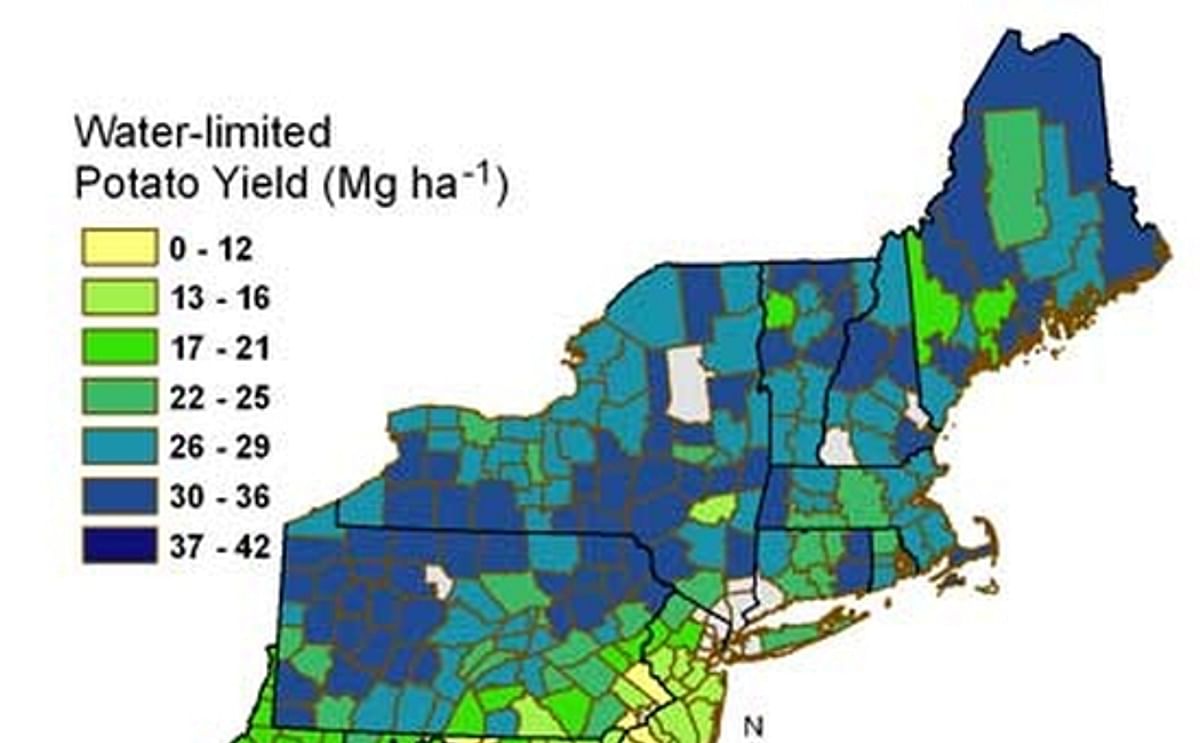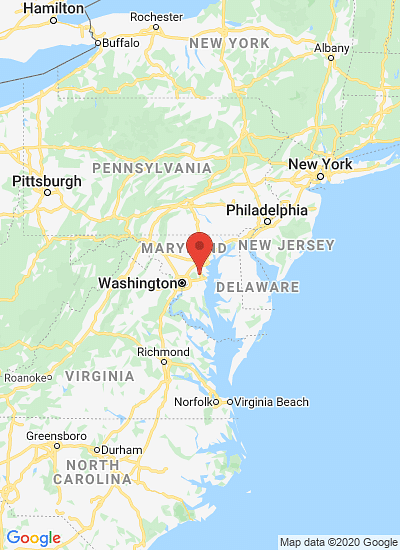Average estimated potato yields for each county in the Eastern Seaboard region, assuming that water was limiting. (Courtesy: Dave Fleisher, USDA-ARS)
Optimizing potato yield - for the entire US East Coast all at once

Farmers are used to optimizing crop production on their own lands. They do soil tests to choose the right amount of fertilizers to apply, and they sometimes plant row crops on some fields while keeping others in pasture.
But is it possible to optimize production across a much bigger area—say, the whole East Coast of the United States? That's the question a team of USDA-ARS scientists in Beltsville, MD, has begun to tackle by developing a sophisticated new modeling tool.
Known as the Geospatial Agricultural Management and Crop Assessment Framework (GAMCAF), the tool brings together crop models that estimate plant growth and crop yield at scales as fine as 30 meters (90 feet), with spatial sources of information on soils, water, land use, and other factors. Crop models aren't normally designed to work automatically with spatial data, explains Jonathan Resop, who led the platform's development as a USDA-ARS postdoc. Now, the new interface—published in the Jan.-Feb. 2014 issue of Agronomy Journal—allows exactly that.
"This way, we can make much larger predictions [of yields] across the entire regional scale," Resop says. But, he adds, "The real power of this framework is that it lets you look at different scenarios of land use change, water, and climate change." For example, what will happen to production if more farmland is lost to development, or if average growing season temperatures rise substantially in coming decades?
What's driving the research are mounting concerns about food security across the Eastern Seaboard Region (ESR). The 13 states between Maine and Virginia (plus the District of Columbia) now have nearly 25% of the U.S. population but only 5-6% of U.S. farmland. The ESR also imports up to 75-80% of its fruits and vegetables from distant places like California.

Not all farmland in the North East US is devoted to food production
"So, the big question from my perspective is: what are the biophysical constraints that limit agricultural production in this region?" Fleisher asks, such as soil quality, water availability, and the amount of cropland. It's a complicated question to answer for the entire ESR at once, so he, Resop and their collaborators started with a single crop: potato.
Why potato? It's a staple food, for one, and yet the ESR grows only about 30% of the potatoes it consumes, according to U.S. Census data. Fleisher's team has also been working on potato crop model for a decade now, making it a good first candidate for integrating into GAMCAF.
When the team used GAMCAF to predict how many potatoes the Eastern Seaboard could produce if all of its farmland was devoted to this single commodity, they found the production capacity could be increased by as much as 40% over baseline values. Capacity did drop off significantly from north to south—which was expected because potato is a cool-season crop—and lower yields were also correlated with denser, high clay soils.
Another key finding centered on water management. "Increasing irrigation, particularly in areas where potato farms are typically rain-fed [such as Pennsylvania] could result in substantial yield increases," Fleisher says.
Of course, these scenarios are hypothetical—the ESR would never put all of its farmland into just one commodity. Fleisher has now added a corn crop model to GAMCAF, is integrating a wheat model, and hopes to add many more. Once other models are included, the scientists can begin examining trade-offs: for example, where in the ESR does potato grow best versus corn or soybean or broccoli? "It's a way to optimize the spatial production of our commodities for our regional needs," he says.
Moroever, the platform now includes climate data, enabling predictions of how future temperature and precipitation scenarios will affect crop yields. It can also examine the effects of land use changes such as farmland loss—or, conversely—of bringing abandoned farmland in places like Maine back into production. Eventually, it might even be used to make similar forecasts for other U.S. regions or the entire country, the scientists say.
But that's not the end of it. The research is part of a much larger effort called "Enhancing Food Security in the Northeast with Regional Food Systems" (EFSNE), led by Penn State University. Funded by USDA-National Institute for Food and Agriculture (NIFA), EFSNE is investigating the benefits that increased regional food production may hold both for consumers—especially in disadvantaged neighborhoods—and for local farmers, retailers, distributors, and others in the food supply chain.
The goal, in other words, isn't just to see how much food the Northeast can grow. Says Fleisher, "We also want to know: what is the value of regionally produced food?"







